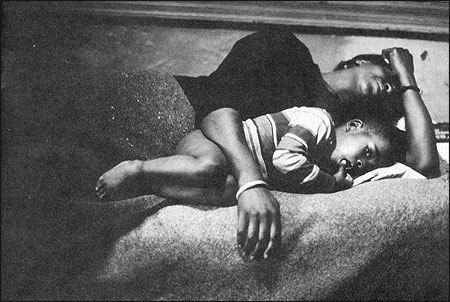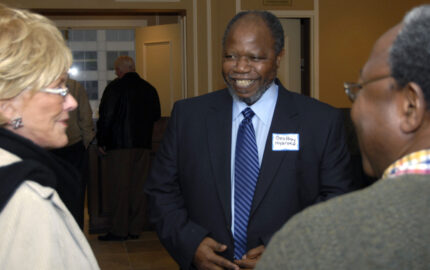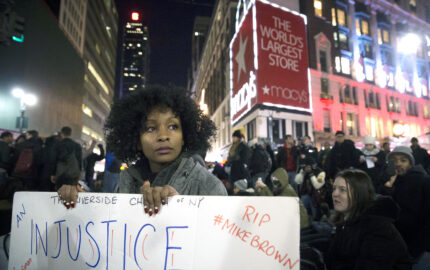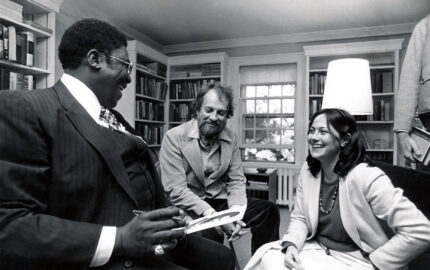In the early afternoon of November 30th of last year, 90 African-American photographers and editors gathered on the steps of a brownstone apartment near Adam Clayton Powell and 125th Street in Harlem. It was the 90th birthday of Gordon Parks, and they had come from across the country to be photographed with the man who had influenced their lives. Parks arrived in a limo with his daughter Toni and Adger Cowans, a man who was like a son to Parks. After several exposures, the session ended. Later that evening, several hundred people gathered at a Manhattan hotel for the birthday celebration. Throughout the evening, Parks greeted and received the strangers and the familiar. There were speeches, toasts and the birthday cake. Throughout it all, Parks sat with a bemused expression on his face.
Gordon Parks was a prophecy long before he was a person. Prior to his conception, it is said that a gypsy woman told his mother that her 15th and last child would be known throughout the world, bringing honor and acclaim to the family. All this from a boy born in Fort Scott, Kansas, where most people, black or white, felt dwarfed by the prairies. Such a prediction was surely not a safe bet for a black man born shortly after Reconstruction, in a country where lynchings were as common as thunderstorms. That he was declared legally dead at birth tended to make the prediction all the more amazing.
The trauma of birth brought to the world a child that neither moved nor cried. Failing to respond, he was wrapped in a blanket and placed in a basket at the side of the bed while the midwife attended to the mother. A doctor asked that some ice be placed in a pan of water. The child’s lifeless form was immersed in the pan. “I started yelling, and I haven’t stopped,” Parks likes to say when retelling the story.
Gordon Parks’s mother died when he was 15, and he was sent to live with an older sister in St. Paul, Minnesota. Shortly after his arrival, a family dispute set him adrift, homeless in a world where hunger, poverty and racism stalked him. Armed with the weapons given to him by his parents, who placed “love, hard work, and dignity over hatred,” he set out to live out the gypsy’s prophecy.
In Minnesota he worked at an assortment of jobs: janitor, musician, semi-professional basketball player, and railway porter. Working on the railroad, Parks came in contact with newspapers and magazines left behind by passengers. Thumbing through the magazines, he discovered the pictures of Depression-era photographers working for the Farm Security Administration, documenting the dust-bowl caravans traveling from Oklahoma to California. “These stark images of these men, women and children, caught in their confusion and poverty, saddened me,” says Parks. “I took them home and kept looking at these photographs for months.”
It was on a trip to Seattle that he brought a Voightlander Brilliant camera from Abe Cohen’s pawnshop for $7.50. “I liked the name,” he remembers. “I hurriedly pulled the money from my pocket—without bothering to inspect the camera.” It would be a serendipitous introduction to what he would later call his “choice of weapons.”
The first roll of film Parks had developed earned praise from the proprietor of a Kodak camera store in Minnesota, who offered to give him an exhibition if the promise he saw in his first roll of film continued. It would be his first of many.
“I’m often asked why I didn’t allow anger and bigotry to maim me,” says Parks. “The answer lies in the goodness of people who, regardless of their color, have reached out to me when I needed help. Without them, the most inconsequential hills would have been impossible to climb.”
Gordon Parks inspired a generation of photographers, black and white, by both his work and his example. And unlike so many great European photo-journalists who were adopted Americans and who saw this country through a European prism, Parks was from the soil that he tilled and, as a black man, he lived both the American dream and the nightmare.
“I would say perhaps his greatest contribution to photojournalism was his recognition, in depth, of the underdog—Harlem gang leader, Flavio, Malcolm,” says former Life magazine editor, John G. Morris.
“Gordon is more than a photographer,” says Pulitzer Prize-winning photographer John White of the Chicago Sun-Times. “He’s more than a hero; he’s a lamplighter, and everyone is illuminated by that. Gordon is our lamplighter, and I love him for that.”
Parks’s images mirror a truth that at times is painful, reflecting both the country’s promise and its failure. But he believes in the redemptive powers of truth and beauty. Both his life and work celebrate the capacity of human beings to rise above adversity and reach for the sublime.
Lester Sloan, a 1976 Nieman Fellow, has been a journalist for more than 30 years, working in print, television and radio. He has worked as a cameraman/reporter for the CBS affiliate in Detroit, a staff photographer for Newsweek in Los Angeles, an at large contributing editor for Emerge magazine, and a contributor to National Pubic Radio’s Weekend Edition. He edits a Web magazine, www.lestersloanmediagroup.com.
Frisco Railway Station, Fort Scott, Kansas, 1949.
"Drugstore Cowboys—1955" Blind River, Ontario, Canada.
Bessie Fontenelle and her son, Richard, from a 1967 Life photo essay about the Fontenelle family and poverty in Harlem.
Photos by Gordon Parks.



